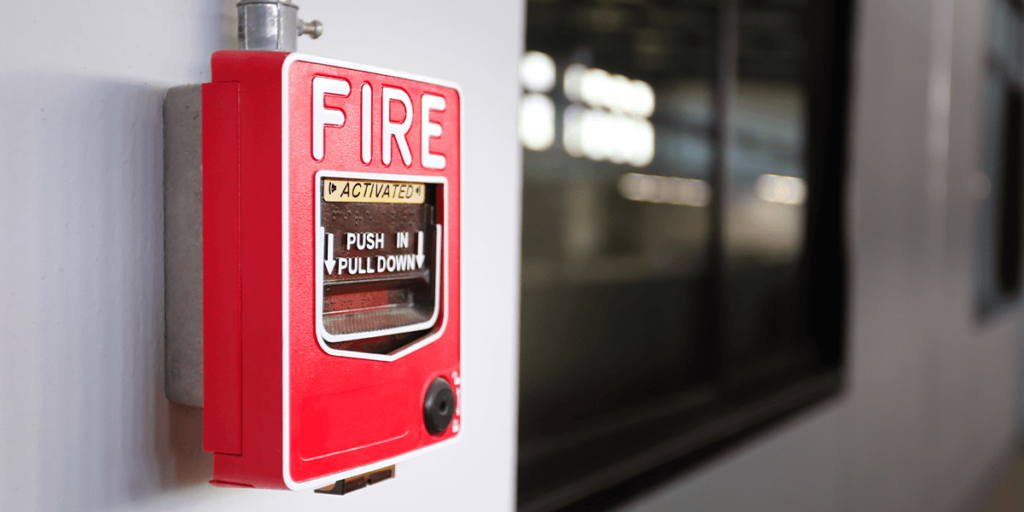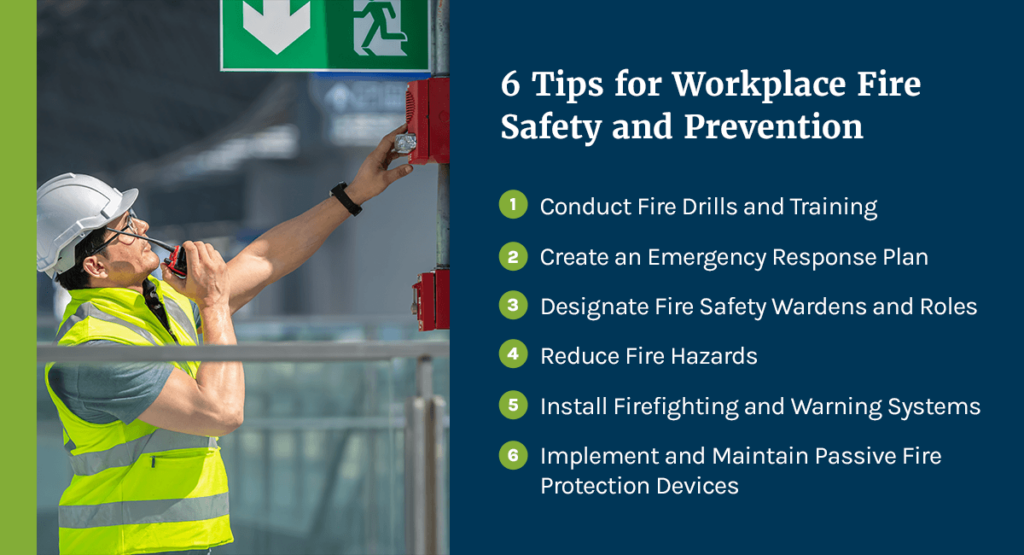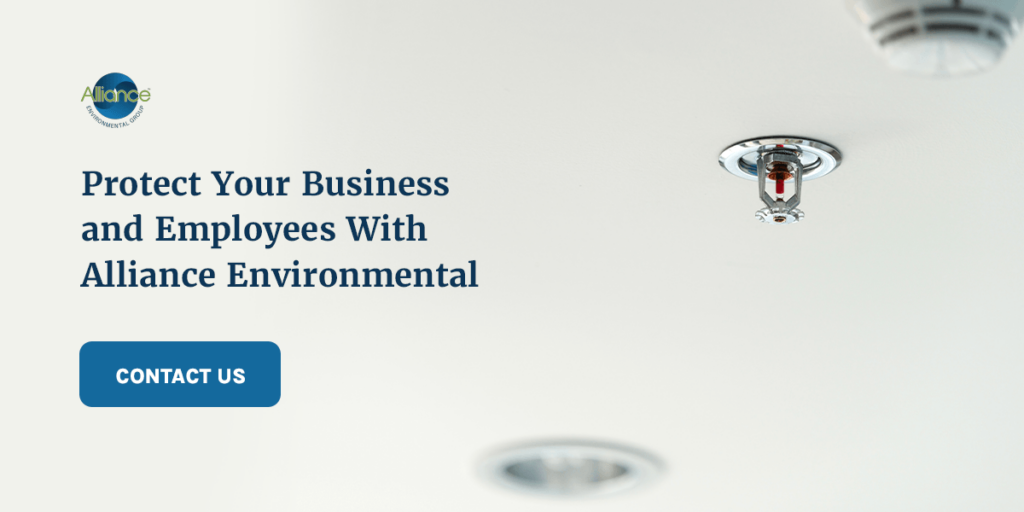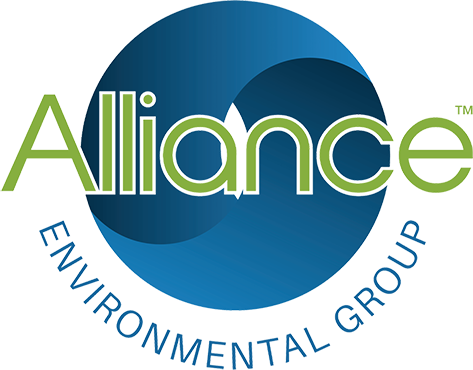
Workplace fires are responsible for significant injury, and many employees don’t know how to use different safety measures, such as fire extinguishers, to keep themselves safe during a fire. Even with the best practices, any business can experience a fire — and without the proper safety measures in place, the results can be devastating. Assets may be damaged, and worse, employees may be injured or experience loss of life.
Using the right fire safety standards and training is critical to ensure employees are prepared to handle an emergency and evacuate without harm. Below, you’ll learn more about workplace fire prevention, how to promote fire safety in the workplace, and the steps you can take to keep your employees safe if a fire occurs.
Employee Responsibilities in Fire Safety
Employers are responsible for keeping workers safe in the event of a fire. Most employers must perform a periodic fire risk assessment, which indicates the risk of a fire in a building and the steps that will be taken to reduce or mitigate this risk. You’ll need to keep your fire risk assessment updated anytime anything changes within your business. Fire risk assessments help protect your workplace and everyone involved in your operation, including employees, visitors and other personnel.
The Occupational Safety and Health Administration (OSHA) also has fire safety guidelines for employers to follow. OSHA fire safety standards state that employers should train their staff about the steps to take during a fire. Training should be provided for evacuation procedures and firefighting equipment. Fire safety and evacuation guidelines are more strict in some industries than others, such as those working with hazardous materials. Different steps employers need to take to keep workers safe include:
- Ensuring there’s access to plenty of fire exits to help employees evacuate quickly
- Installing fixed fire extinguishing systems
- Providing educational training if you have portable extinguishers available
- Developing a comprehensive emergency action plan
- Creating a fire prevention plan
Workers have the right to work in places that don’t cause them harm and receive the appropriate training to manage fire hazards and emergencies in the workplace safely and correctly. As a result, employers are responsible for creating fire safety standards and procedures to protect their staff during an emergency and mitigate overall risk.
6 Tips for Workplace Fire Safety and Prevention
Employers are responsible for ensuring employees have a safe working environment, which includes taking the necessary steps to prevent fires and injuries if a fire does occur. You can use the following tips to help promote fire prevention and safety within the workplace.

1. Conduct Fire Drills and Training
Fire drills are an excellent way to prepare your employees for an emergency. Fire drills allow you to train your employees on evacuation procedures so they know what to do if a fire happens at the workplace. The frequency of your fire drills will depend on the nature of your business.
Most businesses can do fire drills twice annually. However, operations that frequently work with hazardous materials, chemicals or combustibles should do fire drills once every three months. Employees should know beforehand what to do and where to evacuate during a fire so they can act accordingly during a drill.
You should also create fire safety training for employees. This training can include how to prevent workplace fires, respond during an emergency, and use evacuation routes and firefighting systems.
2. Create an Emergency Response Plan
Your business should have a unique emergency response plan for fires. Employees will need access to regular and updated fire safety training customized to your workplace’s specific hazards. Your fire risk assessment will help you determine your workplace hazards and how to address these problems in an emergency response plan.
Your emergency response plan may include designating roles, scheduling drills, creating a check-in location for employees and more. To ensure they’re prepared during a fire, employees will need consistent access to your emergency response plan so they can cultivate awareness of key information such as evacuation routes and safety procedures.
3. Designate Fire Safety Wardens and Roles
Businesses should have at least one person assigned to oversee their fire safety procedures, though ideally, you would have a team of people overseeing these operations. The person designated as fire warden is usually someone from upper management, such as a facility manager, office manager or human resource manager.
Fire safety wardens are responsible for the following:
- Educating employees in fire response
- Raising awareness regarding existing hazards
- Improving and implementing emergency procedures
- Preventing emergencies by assessing fire risks
- Assisting with further fire prevention methods
In larger organizations, you may need to assign a team of people to assist with fire prevention. The team would be responsible for aiding the fire warden during an emergency, which can include finding those left behind during drills or fires, keeping evacuation routes clear, being accountable for specific individuals in an emergency, and assisting disabled or slow-responding individuals with getting to safety.
4. Reduce Fire Hazards
Your fire risk assessment should detail the different hazards in your workplace. Employers are responsible for reducing or removing as many risks as possible to prevent a fire. You should be able to recognize potential dangers and have them promptly removed, which can include steps such as the following:
- Reporting electrical problems or hazards
- Properly storing flammable materials
- Avoiding damaged electrical equipment
- Avoiding overloading circuits and outlets
- Keeping ignition sources and combustibles away from flammable materials and equipment
5. Install Firefighting and Warning Systems
One of the best ways to fight a fire in the workplace is by installing firefighting equipment and warning systems. You should have alarms, detection systems, fire extinguishers and sprinkler systems in place and appropriately maintained at your workplace.
Employees should be trained on properly using fire extinguishers and aware of their locations, which should be easily accessible and close to high-risk areas. Proper implementation of these systems will make it easier to fight a fire if one occurs on your property.
6. Implement and Maintain Passive Fire Protection Devices
You should also maintain passive fire protection devices like fire dampers and fire doors. These tools add another layer of fire protection by isolating flames and mitigating spread. Fire dampers are installed in heating, ventilation and air conditioning (HVAC) units and restrict the spread of fire or smoke throughout air ducts. When dampers sense smoke or increased temperatures, they close off the ducts to halt the fire’s spread.
Fire doors have fire resistance ratings and are built with resilient materials like steel. Their closing mechanisms and seals mitigate smoke and flames.
Facilities need to conduct regular maintenance on all protective fire systems. Maintenance evaluations will make sure the devices can effectively protect your building during a fire.
The National Fire Protection Association (NFPA) has guidelines for door and damper maintenance. You must test fire dampers immediately after installation and periodically to ensure they work properly. Testing intervals for fire dampers are one year after their initial installation, and then every four years following. During these inspections, you check the damper’s position and ability to work correctly. If you notice any damage or failure to function as intended, you must repair the faulty units as soon as possible.
Fire doors also require regular inspections to make sure they work correctly. According to the NFPA, you should inspect fire doors at least once a year. At this time, you should ensure the doors meet all NFPA requirements listed in standard NFPA-80, such as:
- There are no holes or damaged parts on any door area.
- The self-closing operation is fully functional.
- The door meets all clearance standards according to the building dimensions.
Protect Your Business and Employees With Alliance Environmental
All employers must take the appropriate steps to ensure their employees can safely evacuate during a fire while incurring minimal risk of injury. Implementing preventive measures is also critical, especially when working with chemicals or other materials that can combust or spread flames. Alliance Environmental can help you with our fire life safety services.
Our services include fire door and damper inspection, repairs and replacements. We also offer fire sprinkler head cleanings, asset tagging, fire barrier surveys and more. If a fire does occur at your workplace, we provide environmental remediation services to help restore your business to its former glory. You can contact us to learn more about our fire safety and remediation services or request a quote to get started!




